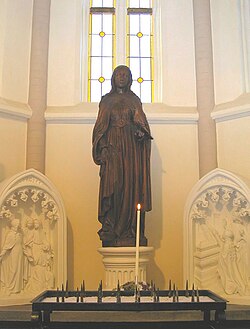Saint Oda
This article relies largely or entirely on a single source. (February 2015) |
Saint Oda | |
|---|---|
 | |
| Born | c. 680 Scotland |
| Died | c. 726 |
| Venerated in | Eastern Orthodox Church, Roman Catholic Church |
| Feast | October 23 |
| Attributes | Long blue gown with one bare shoulder; carries a staff or a book; always shown with a magpie on her hand and a crown under her feet |
Saint Oda of Scotland (c. 680 – c. 726) was a woman,[1] supposedly of Scottish origin, who became a holy woman in the Netherlands.
Life
Oda was born blind[2] and her father sent her on pilgrimage to Liège to visit the relics of Saint Lambert. While praying at Saint Lambert's grave she was miraculously cured from her blindness. The miraculous cure of Oda is recorded in Saint Lambert's 8th century vitae. Vowing to dedicate her life to God, she returned to Scotland.
According to records written in the 13th century, her father wanted her to marry in Scotland. Because of her vow she fled across the North Sea. After a pilgrimage to Rome and Monte Sant'Angelo sul Gargano, she moved to live in an open space in the woods in a place now known as Sint Oedenrode in the Netherlands (a small manmade open space in the woods is called a 'rode' in Dutch - the village is named after Oda).
16th century records describe how Oda prayed in various villages in the Netherlands and Belgium only to be disturbed by magpies. She fled from the magpies and the birds led her to the open space in the forest.
Some accounts describe her as a king's daughter, but as there was no Kingdom of Scotland at that time her background is problematic.
Iconography
Saint Oda is usually depicted wearing a long blue gown with one shoulder bare. She usually carries a staff or a book (symbolic for her cure of blindness). She is always shown with a magpie on her hand and a crown under her feet (symbolic of her rejection of her earthly father's kingdom).
Veneration
Pieces of Saint Oda's skull and teeth are kept in the Saint Martin Church of Sint-Oedenrode. Various statues and paintings are kept in a chapel dedicated to Oda in the church's garden. Pilgrims visited Saint Oda for relief of sore eyes and illnesses related to the head.
External links
- Meertens Institute, database of Dutch shrines and sacred places
- http://www.catholic-forum.com/SAINTS/sainto60.htm
- http://www.catholic.org/saints/saint.php?saint_id=4522
- http://www.crwflags.com/fotw/flags/nl-nb-so.html
References
- ^ "Mystical Magpies and St. Oda". Patheos.com. 2013-10-11. Retrieved 2016-01-24.
- ^ [1][dead link]
